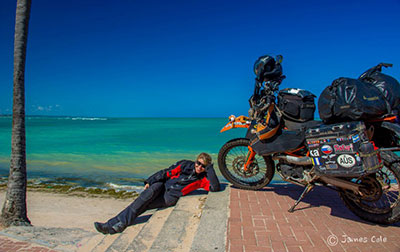Preparing & planning for adventure – Part 1: Luggage
One of the first things you should consider before setting off on any sort of two-wheeled adventure is what type of luggage you need to carry your belongings in.
Unlike a car, where you can toss everything in the boot, motorcycle travel requires a lot more forward planning and preparation.
BMW-R1200GSOver the following pages we’ll describe the types of luggage options available to you, and give you some tips on which ones are best suited for your travel plans.
From the outset, it’s worth noting that there is no one-stop solution to all your requirements. All luggage has been designed with a specific purpose in mind, and the type of travel you are undertaking, and the conditions in which you’ll ride, will determine which you feel is right for you.
Generally, the biggest decision you’ll have to make is soft luggage vs hard luggage. We’ve used both extensively, and in all types of terrains and conditions. While our advice should not be considered gospel, we think we have the experience to give you a good starting point with which to work.
PREPARATION
Before you begin, it’s worth taking into consideration where you’re riding, and what your requirements are. Without going into it in too much detail, your decision will basically come down to whether you are riding on a road or a track.
For the purpose of this story, here’s our definition of both.
Road: A road can be tar or dirt, with a good, even surface across the width of the road.
Track: A track is where there’s a huge variation in the surface and where any change in your position on the road is a consideration. Rocks or vegetation down the middle of the track will have an impact on where you ride.
It’s worth noting that tracks can change from year to year. The Oodnadatta and Birdsville tracks can be a road or a track, depending on the season and what road maintenance has been done before you arrive.
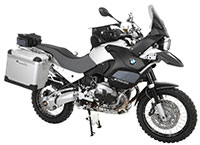

HARD LUGGAGE
PANNIERS
Touring-PanniersRoad use (tar and gravel):
Many riders make good use of the luggage systems made by the bike manufacturer. These are generally fitted with quick release mounting systems that offer the convenience of a suitcase-type pannier. Usually with side and top openings, they are easy to detach when you get to your destination, allowing you to carry them into your accommodation.
However, the side opening versions can create problems, and I’ve seen many people open their suitcase-style panniers at the end of the day, only to have everything fall onto the ground.
The suitcase panniers are usually referred to as touring panniers, often with an aluminium outer skin, but mainly made out of plastic, and these are generally not as robust as the aluminium adventure versions. As such, they are best suited to road riding where you only need to carry light loads, and not for off-road adventuring where uneven road surfaces or carrying extra weight are considerations.
Price range: (touring panniers) $900 to $1400
Capacity: 60 to 70 litres (combined)
Adventure use (tar and gravel):
Pannier-linerVirtually all the aluminium adventure panniers are top opening, with their own sturdy mounting frame. The panniers lock to the frame via an internal or external locking system, which prevents them from being stolen or tampered with, which is a real consideration when travelling in some areas, and in countries where security is a concern.
The top opening systems don’t offer the suitcase convenience, however liner bags are available, and these can be easily removed for overnight stops. If you’re living off your bike (eg: carrying food), the top opening panniers are far more convenient.
The key to the strength of these panniers is the mounting system, which also helps to protect them from damage should you happen to drop the bike or have an accident. Their sturdiness also gives them reasonable field reparability, so that they can be fixed on the run.
Aluminium adventure panniers, such as the Touratech units pictured, are definitely stronger and more durable than the touring units.
Price range (aluminium adventure): $1900 to $2300, including pannier racks.
Capacity: 60 to 90 litres (combined)
What size to use:
The size of the pannier you choose will usually depend on the size of your bike, and what your carrying requirements are. You should try to keep the total width of your bike to one metre or less, and the following is a good rule of thumb:
* Single cylinder adventure bikes with twin exhaust (e.g.: Husqvarna Terra, BMW G650GS, KTM 690, Yamaha XT 660 Tenere) – 31 litre pannier on each side
* Asymmetrical bikes, such as the Suzuki DR650 – 31 litre pannier on the exhaust side, 38 litre pannier on the non-exhaust side. This helps to keep the bike symmetrical and keeps the weight even.
* Larger symmetrical bikes (e.g.: KTM 990/950 LC8) – 2x 38 litre panniers.
* Large asymmetrical bikes (e.g.: BMW GS1200, BMW GS800, XT1200Z, Triumph Tiger 800, KTM 1190) – 38 litre pannier on the exhaust side, 45 litre pannier on the non-exhaust side.
Handling note:
Adding panniers does effect the handling of the bike, however it is not as significant as you might think. For example, I’ve put a tractor battery in one side of a BMW pannier box and thought it would make it incredibly dangerous to ride, but I hardly noticed it.
Having said that, you want to try and balance the load, and certainly put heavy items at the bottom.
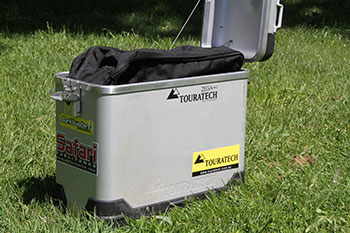
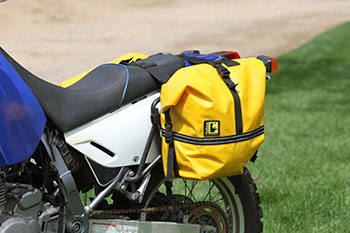
SOFT PANNIERS
PVC-panniersSoft panniers are lighter and narrower, and are usually constructed from PVC waterproof fabric, or canvas.
The canvas versions need to be at least 16oz canvas, with the most durable using rip-stop canvas, similar to the Australian-made units available from Andy Strapz.
If you want PVC panniers, you should be looking at PVC panniers that have a fabric thickness of at least 300 grams per square metre (gsm), but preferably a fabric that’s around 400-500 gsm, which will assist in the pannier’s durability. Giant Loop and Wolfman are two of the more popular brands.
Soft panniers are highly durable in some regards, but if you fall off there’s an increased chance of damaging the contents of your pannier, or the pannier itself.
Even in the event of an accident they often surprise you as to how durable they are. I fell off heavily in rocks at speed with a fully loaded adventure bike, and didn’t damage my set of rip-stop canvas panniers, which surprised me, although it did damage some of the contents. In this situation, even an aluminium adventure pannier would have been damaged significantly.
However, in the event of a fall, you could loose the water proofing ability of the soft pannier, so you’ll need a secondary means of waterproofing.
Some brands are a lot more durable than others. A brand that offers superior waterproofing will not always offer the best durability, and vice versa.
The lack of robustness in soft panniers is a definite trade-off for its compactness, however one advantage is that you can also move the luggage further forward, and it doesn’t require the big pannier rack systems. Items also don’t move around as much in soft panniers, because you can tighten the straps to keep everything held securely.
Soft panniers are considerably cheaper than hard luggage systems – usually less than half the price.
Price range: $600 – $800, including frame to suit soft pannier
Capacity: 35 to 45 litres (combined)
Where to use them:
Soft panniers can be used anywhere, however they are more commonly used on tracks and for hard-core adventuring, where the narrower width makes it easier to manoeuver your bike, and when you don’t need to carry as much luggage.
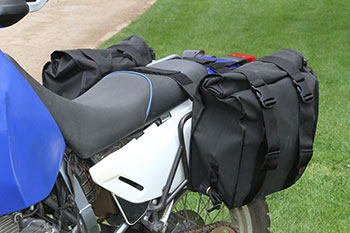
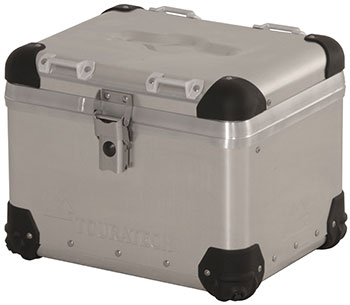
TOP BOXES
Top boxes are very convenient for bulky or light items. It’s very important that you don’t put a lot of weight in them, as any weight behind the back axle has a counter levering effect on your handling.
On tar roads there’s little to no effect, but once on looser surfaces it can become a real safety concern.
All top boxes have very clear weight limits on them. Stick to the recommended weight, as the manufacturer has specified this for a good reason.
Top boxes are very convenient for helmet storage, and other light items, and give you valuable extra storage space on your trip.
Our advice would be that if you are doing extended adventure touring, use the aluminium adventure style top box, particularly where rough surfaces will encountered.
Capacity: 25 to 40 litres
TANK BAGS
Tank-BagTank bags have been prominent on road bikes for a long time, but have found their way more and more into the adventure market, and the dirt bike and enduro bike scene in recent times. What a tank bag offers is a convenient spot to carry the things that you want to grab quickly – cameras, goggles, phone, wallet, etc., and all within easy reach.
Most of them now have a clear map case on the top, and this is really beneficial and is one of the key things I look for in a tank bag. The little side pockets for earplugs, sunglasses and those types of things are very useful as well.
The dual size bags that can extend are quite useful on bigger bikes, even if you don’t use it very often. You can also use the bags as a convenient spot to put light clothing, such as a fleece jacket.
They need to be the type that strap on to the bike.
You’d think that having a tank bag would be a major inconvenience for refuelling, but they have quick, detachable methods, and after a while you don’t even notice it. It’s certainly not an issue.
It’s worth noting that very few are 100 per cent waterproof. To a point, they’ll cope well in wet weather, but the only way to make them fully waterproof is to have the waterproof cover that goes over them – and this also has the clear top, so you can still read your map in the wet. You MUST put the waterproof cover on before it rains, otherwise they will steam up and you won’t be able to read your map.
Zip care is also very important. Zips are usually the first item that gives you trouble, so treat them carefully.
Price range: $180 to $450
Capacity: 4 to 26 litres
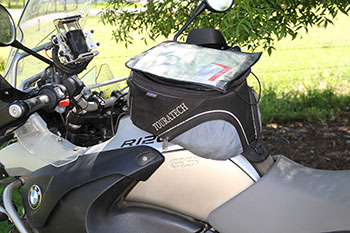
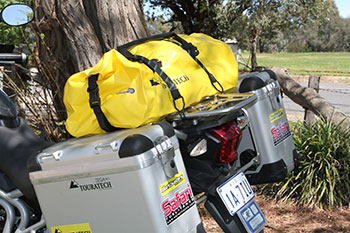
DRY BAGS
Dry-BagAttached to the back of your bike, dry bags are for the lightest or bulkiest items you need to carry, such as a tent or clothing for extended travel or camping. They usually strap across the back of the bike or on the seat, and overlap over onto your pannier system.
A good quality dry bag is important and the thickness needs to be 400-500 gsm, and it must be waterproof with a roll down top.
Most have nice convenient straps and strapping points to tie it down securely during travel. They can also double as a duffle bag or, at a pinch, as a backpack.
Dry bags come in various sizes, but those around 45-50 litres work well and are certainly the most popular. The monster ones – 80 to 90 litres – are bigger than what most people need, even though you can compress them down.
On small bikes where you are doing more serious adventure riding, the small dry bags, in the 30 to 35 litre range, are ideal because they are light and take up less space.
Dry bags are also good in an accident, because if you fall off it’s unlikely the bag will get damaged as it will be the last thing to hit the ground, but they need to be very well strapped on.
The strap systems we use are ROK Straps, which are an Australian designed product and they just work. They’re a really solid, durable brand, and are also very cost effective.
Price range: $150 to $200 (dry bags), $5 to $25 (ROK Straps)
Capacity: 30 to 90 litres
BACKPACKS
Typically in adventure riding, you want to reduce the weight you’re carrying. Backpacks are convenient and some people like them for short trips, but it’s nice to not have something on your back all the time.
Being lightweight and easy to transport, they can be used for shopping bags on long trips, without having to unpack your whole bag.
A backpack that contains a hydration system can be an essential item in hot weather, enabling you to sip some fluid on the run, without having to stop.
The convenience of a backpack is handy, but use it for the convenience only, not as one of the key parts of your luggage transport.
Capacity: suggested no greater than 35 litres
In conclusion:
In the end, the choice on luggage is entirely yours, depending on your wants, needs and budget. Choose wisely, and enjoy your next big adventure.
In the next issue of Adventure Rider Magazine we’ll move onto clothing, and discuss the riding gear and clothes that you’ll need for your trip.
– Robin Box
SIDE BAR – SHERRI JO WILKINS
On her three-year, 128,000 kilometre ‘Because I Can’ world tour, Sherri Jo Wilkins (pictured right) rode a KTM 690 with black aluminium adventure panniers fitted.
Sherri Jo wanted the security and locking ability that the aluminium panniers provided, while she chose black panniers that were less obtrusive and didn’t stand out in countries where security concerns were high.
Picking the right luggage combination before she started her marathon journey proved to be an inspired move, as it caused her no problems throughout her adventure.
